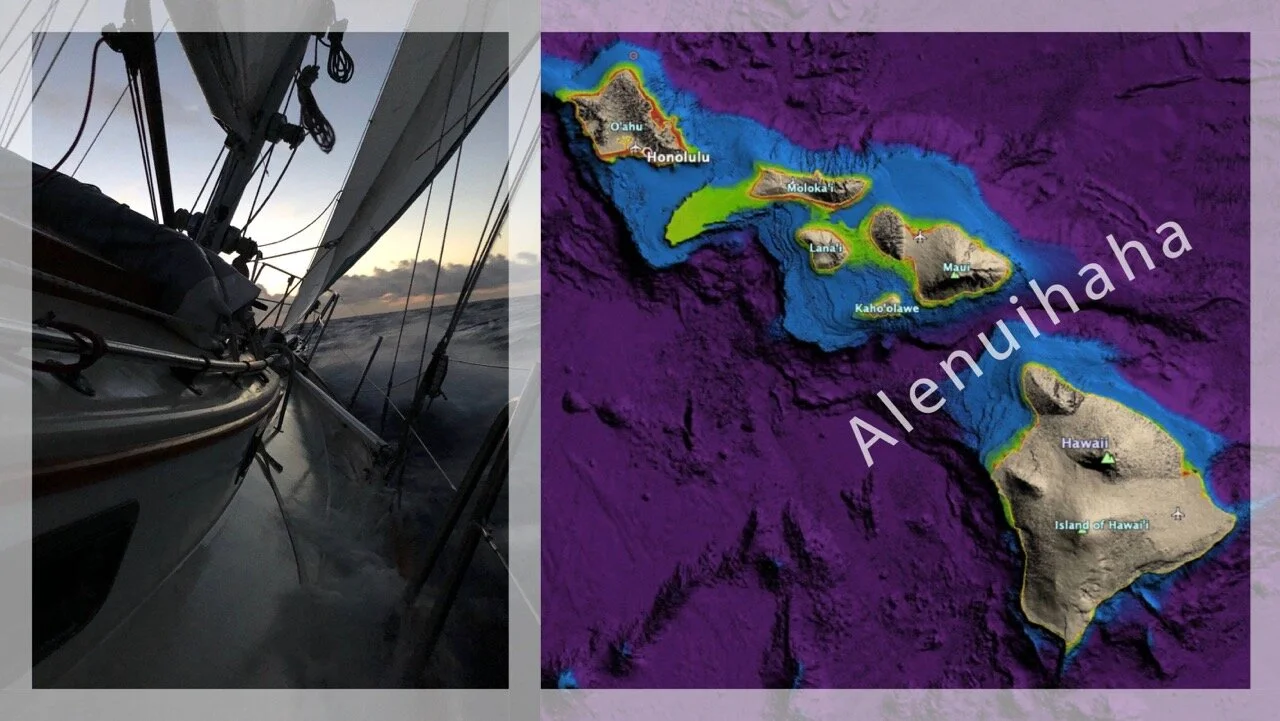Hawaii Sailing
A Paradise for ocean sailors
Sailors love the variety of sailing conditions they experience sailing around the Hawaiian Islands making Hawaii the perfect venue to practice interisland passage making or receive sailing instruction focused on bluewater skills.
Hawaiian sailors routinely sail conditions that are tropical by nature — yet, the weather in Hawaii is often variable — influenced by cool air descending from high volcanos, or changed by the occasional weather front.
When you also consider the potential for big surf that Hawaii is renown for, it’s fair to say Hawaiian sailors have access to the ingredients that create a fun oceanographic world — all of which provide the full-spectrum of natural elements you need to experience sailing to the fullest extent possible — meaning, you can sail idyllic conditions one day, and venture out into extreme conditions the next to challenge yourself.
Hawaiian Islands Make Their Own Weather
Let’s look specifically at Hawaii Island for a moment — the island is so “large” that locals call it Big Island which refers to something greater than just its square area — Hawaii Island is BIG for many reasons!
Big Island’s topography rises sharply from sea level to 13,796’ where the summit of a dormant volcano called Mauna Kea is only 15 miles from the coast — impressive indeed — but, Big Island is also home to the largest mountain in the world named Mauna Loa when measured from sea floor to summit!
The island of Hawaii is so geographically significant that 10 of Earth’s 14 Climate Zones are found there: Tundra to Desert — with contrasting differences of rainfall on opposite sides of the island. In fact, the city of Kailua-Kona (Big Island’s leeward coast) is “dry” and reports 2” of rain monthly, while it’s windward city Hilo reports 14” of rainfall / month.
Hawaii Sailing offers equal parts — relaxation, challenge, and skill development.
Sailing in the Hawaiian Islands
Easterly Trade Winds of 12-18 knots generally flow across the Hawaiian Islands. Occasionally northerly winds impact the islands too when cold fronts descend from the northwest. Hawaii sailing conditions offer great variety — winds between 5-35 knots are commonly experienced during a week of Hawaii sailing depending on the regional barometric wind field, and whether we’re sailing in the lee of a volcanic mountain, or experiencing accelerated winds as we sail interisland passages across channels where Trades Winds are propelled between cold mountain-air and warm coasts.
Sailing in the lee of high volcanoes offers protection from easterly Trade Winds — thus, the west coasts of the Hawaiian Islands consistently provide incredibly fantastic sailing conditions!
Interisland Hawaiian channels, like the Alenuihaha Channel between Maui and Hawaii Island, or the Pailolo Channel between Molokai and Maui can produce winds that exceed 35 knots when land/sea temperatures have a relatively high difference and when the barometric pressure-gradient is also steep — sometimes “channel-winds” will blow 15 knots higher than average Trade Winds found elsewhere in the island chain on the same day! Wind conditions around the northern and southern-tips of Hawaiian Islands tend to also “wrap-around” and blow to Gale Force along a leeward coast.
Hawaii sailing conditions can be predicted by aware sailors if they understand the dominant weather phenomena affecting the locale.
Coastal air-temperatures around the Hawaiian Islands fluctuate daily as warm sea breezes blow during the day between 75-85º F, and cold land breezes descend from volcanic mountains at night to chill the coast to 58-72º F.
Squally weather is infrequent but occurs year-round due to frontal passages, upper-atmosphere troughs, or when low pressure systems pass near the Hawaiian islands and bring moist-air to the region. Windward coasts feel tropical as humid easterly Trade Winds condense and rain as they ascend windward facing volcanic mountains.
Sailors know Hawaii is renown for epic surf
Ocean swells come to Hawaii from every corner of the Pacific Ocean — from the Tasman to Bering Sea, thousands of miles away!
During winter months, Hawaii’s coastlines will experience ground swells, meaning that wave periods of 12-16 seconds roll across the ocean waters of Hawaii. Because the wave periods are relatively far apart and the coastal waters of Hawaii’s shores are relatively deep, Hawaiian sailors experience gentle rolling swells at sea, and can anchor safely outside the surf zone and find respite in a beautiful and remote anchorage most of the time.
Winter ground swells are barely recognizable in deep water but peak-up near shore in 30 feet of water-depth. When strong winds blow, wind-waves of 6-8 feet are produced offshore and along Hawaiian coasts where the shore is directly exposed to the wind. Summer swell conditions are relatively flat unless Hurricane winds produce storm waves in the Central Pacific Ocean.
Hawaii Sailing — a paradise experience for sailors seeking to challenge themselves and enjoy remote anchorages.


